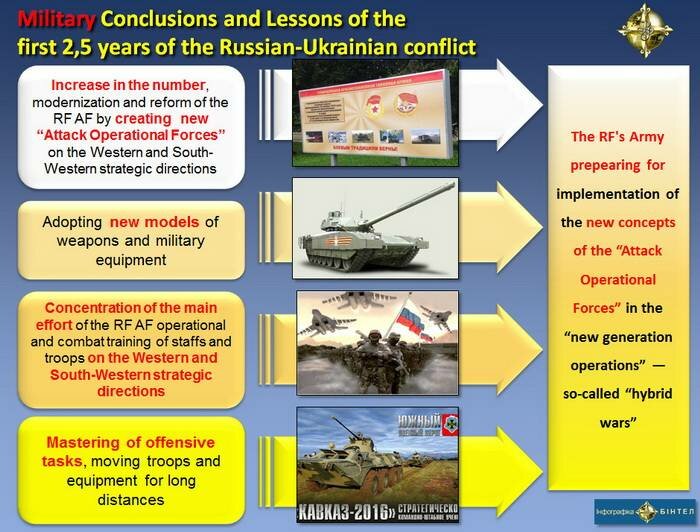
Yuriy Radkovets
Today, is two and a half years since the beginning of Russia's cynical occupation and further annexation of the Ukrainian Crimea and Russia's armed aggression against Ukraine at the Donbas.
The vast majority of leading international and domestic, both state and independent political analysts, political-military experts, military experts and analysts agree in the same opinion, that within the framework of the insidious neo-imperial “hybrid policy” Russia has been unleashed and is now continuing against Ukraine the so-called “hybrid war” that is a full war — “hybrid” in form and “asymmetric” in content. Its difference is characterized by conducting aggressive military operations under the guise of illegal (informal) armed forces and the simultaneous use of a wide range of political, economic (including energy, trade and economic), as well as information-propaganda activities, with which, as a rule begins this “hybrid warfare” and which accompany it throughout the period of hostilities. A number of leading Western experts not without reason have called it another “war of the new generation” or “a new generation warfare”.
The Russian strategy of such a war is directed first of all against the weaknesses of Ukraine and the West (USA/NATO), but not against their strength. The war of the new generation differs from the majority of expert opinions — assessments of the “hybrid” conflict in that it combines the unrepresentative, covert support by the aggressor state of illegal armed groups with its immediate, full and even with elements of bravado intervention at all stages and in all forms. Certain aspects of this strategy were manifested earlier in Chechnya, Moldova and Georgia, but in Ukraine Russia is simultaneously testing and improving this strategy.
However, for this quite a long time (2.5 years), neither in Ukraine nor in the West, there have been carried out thorough researches to analyze and estimate the conclusions and lessons of this “hybrid war” that should form the basis for the development of the security and defence sector of both individual countries and coalitions of countries in the context of the “wars of the new generation”. A pleasant exception was the study “Russia's New Generation Warfare” by the US Research Fund “Potomac” under the leadership of its President — a leading expert on international security and military strategy — Dr. Phillip Karber, which provides ten most important military-strategic and operational-tactical lessons “…that the US Army should learn from this Russian-Ukrainian conflict …the most large-scale conflict in Europe since the Second World War”.
This is not surprising, since this world-known scholar , international relations and military expert has personally visited the Donbas more than twenty times, including directly combat formations in the conflict zone. By the way, an abridged version of Dr. Philip Karber's study in collaboration with the military expert Joshua Tiboltom “Russia's New Generation Warfare” given by them specifically for the Center “Borysfen Intel”, was published in the geopolitical analytics journal “BINTEL”, Issue 2.
Experts of the Independent Analytical Centre for Geopolitical Studies “Borysfen Intel” in April 2016 completed the intermediate analytical study on the results of the first two years (2014-2016) of the Russian-Ukrainian conflict themed “Russia's Armed Aggression against Ukraine: Peculiarities of the Preparation and Conduct; New Challenges and Threats”, the results of which have been tested both in Ukraine and abroad and found appropriate recognition and support. Today we will continue the study of the main results and lessons of Russia's “hybrid war” against Ukraine, which, in our opinion, may be useful for the improvement and development of the security and defense sectors in the situation of Russia's planning, preparation and conduct of “new generation wars” against the united Europe (EU), the USA/NATO and other countries, including in the former Soviet territories.
Geopolitical (Political, Military — Political) Conclusions and Lessons
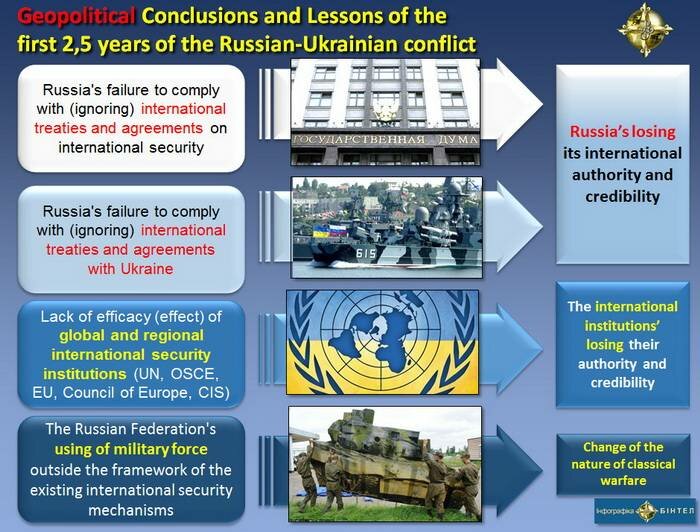 Since the collapse of the Soviet Union, the Russian Federation, in violation of the norms and rules of international law, has brazenly continued its practice of “hybrid policy” towards international organizations and other countries, including post-Soviet ones.
Since the collapse of the Soviet Union, the Russian Federation, in violation of the norms and rules of international law, has brazenly continued its practice of “hybrid policy” towards international organizations and other countries, including post-Soviet ones.
Among other things, this is reflected in the abolition by the State Duma of the Russian Federation in December 2015 of the primacy of international law (basic principles of international law, which are imperative provisions) in the national legislation of a country. That is, Russia now will “legitimately” ignore its (in accordance with the international treaties and agreements), signed and ratified commitments, as well as the implement in its domestic (national) law norms and standards, “…which will contradict its national interests”. The above-mentioned is confirmed by a number of geopolitical conclusions and lessons derived from the results of Russia's 2.5 year long “hybrid war” against Ukraine, namely:
- Russia's failure to comply with (ignoring) international treaties and agreements on international security, preservation of statehood, protection of independence and territorial integrity of sovereign states (the UN Charter /Ch.1, Ch.4, Ch.7, Ch. 8/; the Helsinki Final Act/1975/; Memorandum on Security Assurances in Connection with Ukraine's Accession to the Treaty on the Non-Proliferation of Nuclear Weapons /the so-called “Budapest Memorandum”, dated December 5, 1994/) and as a consequence — its losing the international authority and credibility;
- Russia's failure to comply with (ignoring) international treaties and agreements with Ukraine (Agreement between Ukraine and the Russian Federation on the Status and Conditions of the Russian Federation's Black Sea Fleet's Stay on the Territory of Ukraine of May 28, 1997, the Treaty of Friendship, Cooperation and Partnership between Ukraine and the Russian Federation of May 31, 1997; the Agreement between Ukraine and the Russian Federation on the Russian-Ukrainian State Border of January 28, 2003), and as a consequence — the loss of its international authority and credibility of the CIS member states;
- lack of efficacy (effect) of global and regional international security institutions (UN, OSCE, EU, Council of Europe, CIS) or their incapability (or unwillingness) to interfere into solving present-day international (interstate) conflicts, armed conflicts and local wars and as a result — their losing international authority;
- the Russian Federation's resolving of inter-state conflicts by inadequate and excessive involvement of military force outside the framework of the existing international security mechanisms. Shifting the attention in military conflicts to the asymmetric use of military force by illegal (informal) armed formations, as well as shifting the emphasis in the conduct of armed conflicts to integrated use of military and non-military instruments (political, economic, informational, psychological, etc.), which fundamentally changes the nature of classical warfare.
Economic (Military-Economic, Energy, Trade-Economic) Conclusions and Lessons
-
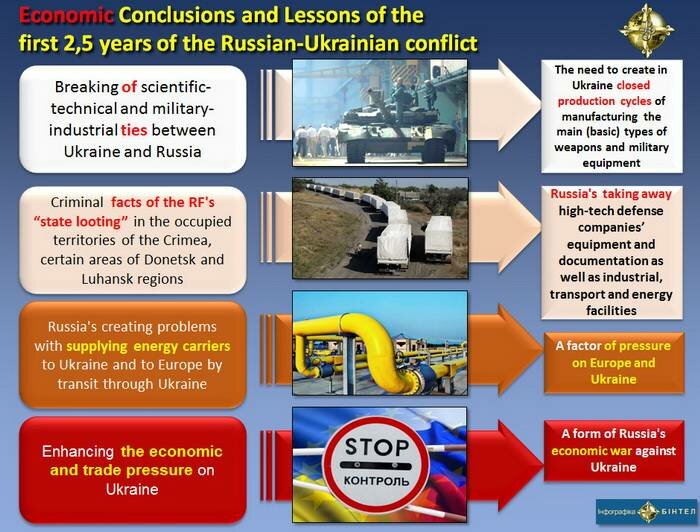 Because of the actual breaking of scientific-technical and military-industrial ties between Ukraine and Russia (in the situation of Russia's military aggression against Ukraine), it is extremely important and critically needed to create in Ukraine closed production cycles of production of the main (basic) types of weapons and military equipment — by both, upgrading technology infrastructure of the existing and creation of new defense enterprises, including in cooperation with Western and other countries.
Because of the actual breaking of scientific-technical and military-industrial ties between Ukraine and Russia (in the situation of Russia's military aggression against Ukraine), it is extremely important and critically needed to create in Ukraine closed production cycles of production of the main (basic) types of weapons and military equipment — by both, upgrading technology infrastructure of the existing and creation of new defense enterprises, including in cooperation with Western and other countries. - The criminal facts of the Russian Federation's “state looting” in the occupied territories of the Crimea, certain areas of Donetsk and Luhansk regions (taking away equipment, technical and technological documentation of high-tech (science-intensive) defense companies and facilities of electrical, metallurgical and chemical industries, as well as transport and energy engineering.
- Russia's using a wide range of problematic issues on energy carriers supplies to Ukraine, first of all natural gas (volumes, duration, price policy, enslaving terms of pre-paying and paying) — as a factor of pressure on Ukraine, as well as energy carriers supplies to Europe by transit through Ukraine (volumes, transit policy, delivery routes) — as a factor of pressure on Europe and Ukraine.
- Enhancing the economic and trade pressure on Ukraine, as a form of Russia's economic war against Ukraine, by:
— The Russian Federation's systematic violation of the rules and regulations of the Treaty on CIS Free Trade Zone signed on 18 October 2011, and since 2016 — the Russian Federation's cancelling (in violation of the provisions and requirements of the World Trade Organization — WTO) the regime of free trade zone with Ukraine; introduction of food embargo against Ukraine and a ban on the transit of Ukrainian goods to other countries of the CIS via Russia's territory;
— Violations (under the pressure from the Russian Federation) by the member countries of the Eurasian Economic Union (Armenia, Kazakhstan, Kyrgyzstan, Belarus and Russia itself) of norms and rules of the WTO in the course of anti-dumping and safeguard investigations.
Military (Military-Strategic, Tactical, Military, Military-Technical) Conclusions and Lessons
- Increase in the number, modernization and reform of the Russian Armed Forces by establishing a new “Attack Operational Forces” (as part of the restored and new attack troop units — mechanized infantry, armored, airborne/air assault/divisions and special forces) on the Western and South-Western strategic directions, as well as adopting new models of weapons and military equipment, reconnaissance and electronic warfare systems and means, means and systems of secure communications, automated command and control systems.
It is important for all of us to understand and to remember that intimidation with force has always been an important element of Russia's policy (to date, of Russia's “hybrid policy”), which should be taken very seriously. Especially taking into consideration today's realities, which are derived from the ratio (comparison) of the Russian Federation's military forces on the Western and South-Western strategic directions to the military capabilities of NATO in Europe, which is not in favor of the Alliance, especially with regard to main battle tanks (MBT) , armored fighting vehicles (AFV), multiple launch rocket systems/MLRS/and artillery systems (including self-propelled ones).
- Concentration of the main effort in the planning and carrying out of the activities of operational and combat training of staffs and troops of the Armed Forces of the Russian Federation when mastering on the Western and South-Western strategic directions (usually during unannounced inspections of readiness of troops and forces in cooperation with other law enforcement agencies and bodies of central and local authorities, as well as of the “West” and “Caucasus” SCPE) of offensive tasks (including through deep offshore operations/actions/in the territory of an imaginary enemy), moving troops and equipment by all modes of transport and under its own power for long distances (including from the Central and Eastern Military Districts) in order to increase the offensive capabilities of its troops in the most successful operational areas, deploying the combat controls and comprehensive support in the field and such like.
In the case of Ukraine, this kind of unannounced inspections and exercises were used as operational cover of the mass movement of military units of the RF Armed Forces as part of their preparation for the illegal annexation of the Ukrainian Crimea and cynical aggression in the East of Ukraine.
That is, while the armies of the USA, NATO and the EU over the past two decades, had been practicing during military trainings the tasks of their national and joint military contingents' participation in international peacekeeping operations, the Russian Federation's Army at the same time had been upgrading and reforming for verification and practical implementation of the new concepts of creation and application of the “Attack Operational Forces” of the Russian troops in the conditions of preparation and conduct of the “new generation operations” — that is, of the so-called “hybrid wars”.
- The radius of destruction of the deployed in the occupied Crimean Peninsula Russian weapons systems of antiaircraft and antiship defense, as well as the planned for redeployment and deployment in the Crimea “Iskander-M” tactical missile complex and Tu-22M3 long-distance missile-carriers bombers, according to Western and Russian military experts' estimates, will be able to cover more than 90 % of the Black sea.
In such circumstances, if Russia wishes, it can block the Black Sea straits on the South-Western strategic direction (this task began being constantly practiced even before the occupation of the Crimea), using the forces stationed in the Crimean Peninsula, with the support of troops and forces of the Southern Military District and the Black Sea Fleet of the Armed Forces of the Russian Federation.
Similarly, Russia can block the Baltic straits on the Western strategic direction, using the forces stationed in the Russian enclave — Kaliningrad region (in view of the deployment in the enclave of “Iskander-M” missiles), with the support of troops and forces of the Western Military District and the Baltic Fleet of the RF Armed Forces.
According to the leading Western experts' estimates, which coincide with the results of the analysis of the “Borysfen Intel”'s experts, the latter option may precede the onset of the Russian Federation's military aggression against the Baltic states and Poland with the use of the phenomenon of “Suwalki Corridor”/“Suwalki Gap”/ (see “They Have Learnt Nothing from History — 2”, of February 5, 2016). And indeed, it is very threatening and quite real.
That is, Russia were preparing for a large-scale war against the West (NATO/USA, EU), the newly formed 1st Guards Tank Army and the 20th Guards Combined Arms Army of the Western Military District of the RF Armed Forces (including the two newly formed Divisions/the Tank one — in Boguchar of Voronezh region and the Motorized Rifle one — in Yelnya of Smolensk region — see “They Have Learnt Nothing from History” of January 23, 2016) on the Western strategic direction — it is a handy tool for using them in a large-scale (conventional) war.
So, it can be one of the possible variants of Russia's unleashing a large-scale war, which is still relevant, — against NATO and the united Europe (EU), that is — the Third World War, with unpredictable consequences.
As for the features of the situation on the South-Western strategic direction, according to “Borysfen Intel”'s experts, the vector of the potential threat of possible beginning by Russia of a large-scale war against the West (the USA/NATO, EU) is gradually “slipping” to the southern flank of NATO.
In that area is located the knot of strategic contradictions between Russia and the West (the USA/NATO) and Ukraine, associated with problems that require urgent solutions, namely: Russia's occupation and subsequent annexation of the Ukrainian Crimea; the unprecedented build-up of Russia's military potential on the South-Western strategic direction (including the being newly created Motorized Rifle Division in Novocherkassk, Rostov region — see “They Have Learnt Nothing from History” of January 23, 2016), including in the Crimean Peninsula and in the waters of the Black Sea and the Mediterranean; Russia's constant encroachment on the control over the Black Sea straits; Russia's plans to deploy in the Crimea “Iskander-M”s and to base Tu-22M3 long-range missile-carriers bombers; the Warsaw Summit of NATO's decision on introduction of the entry-level of operational readiness of the anti-missile complex in Romania (in Deveselu) of the Aegis Ashore US/AD in Europe, etc.

|
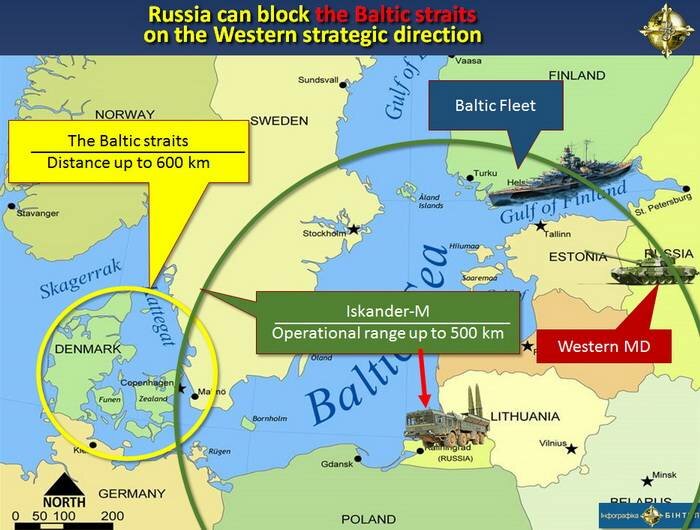
|
According to a number of Russian military experts, not Poland and the Baltic countries, but Bulgaria and Romania — are the most vulnerable members of NATO. According to their own estimates, the most vulnerable region of Europe is the Balkans. Besides, according to some independent experts, as a result of the continuation of Russia's policy of genocide towards the Crimean Tatar people, whose resistance has been growing steadily, in the Crimea can be expected the Kosovo precedent.
And how high is a possibility that Russia will try to use the “Crimean” and the “Balkan” factors in its confrontation with the West (the USA/NATO, EU)? It is high enough, and this factor is not totally implausible! After all, two and a half years ago no one in the West thought that the Ukrainian Crimea would be captured and annexed by Russia. No one in the West expected anything like this then!
However, this issue is the subject to a separate study, the results of which will be published by the experts of the “Borysfen Intel” Centre in the nearest future.
- occupied by Russian occupation forces (Russian-terrorist forces) Ukrainian Crimea and parts of Donbass actually turned into a research ground for trials and testing both upgraded and new Russian weapons and military equipment, as well as for use of a prohibited (non-conventional) weapons, as well as to test new concepts of creation and application of Russian troops, including information and special operations.
Thus, among the identified to date and modernized samples of new weapons and military equipment of the Armed Forces of the Russian Federation should be noted:
- Tank T-72B3;
- “Grad”, “Smerch”, “Uragan”, “Tornado” MLRS;
- “Rys”, “Tigr”, Ural-63095 “Typhoon” armored vehicles;
- 2S4 “Tulpan” self-propelled mortar;
- TOS-1 “Buratino” heavy flame-throwing system;
- “Tor”, “Buk-M1” and “Buk-M2” anti-aircraft missile systems;
- “Pantsir-S1” air defence missile-gun system;
- “Zoopark-1M” intelligence complex, 1L222 “Avtobaza” signal intelligence station, 1L267 “Moskva-1” signal intelligence and control complex;
- “Torn-MV” automated radio control complex;
- “Rtut-BM”, “Shipovnik-Aero”, “Leer-2” (VDV), 1RL269 “Krasukha-2”, 1RL257 “Krasukha-4”, MKTK-1A “Judoist” electronic warfare complexes;
- “Takhion”, “Forpost”, “Orlan-10”, “Eleron-3SV” Unmanned Aerial Vehicles (UAV);
- 9K333 “Verba” MANPADS;
- “Shmel-M” infantry rocket flame thrower;
- 1L271 “Aistyonok” and PSNR-8M radars.
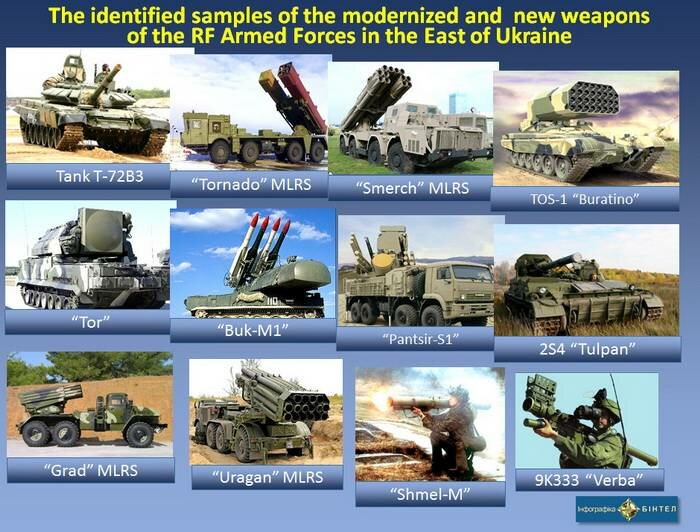
|

|
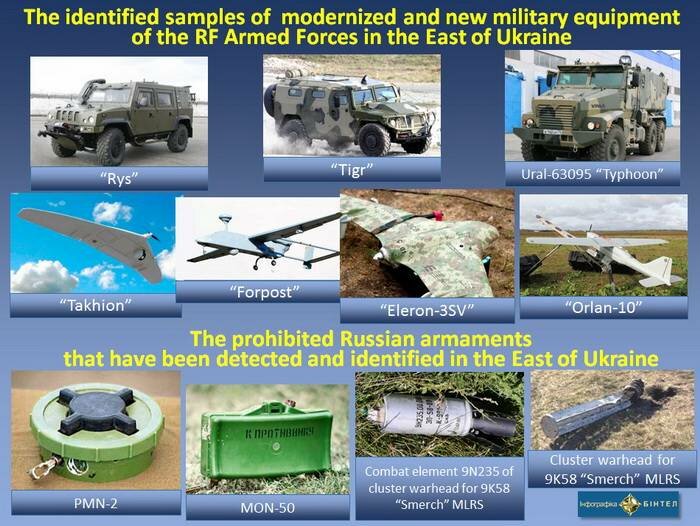
|
At the same time, the following prohibited Russian armaments have been detected and identified in the East of Ukraine:
- Cluster warhead for 9K58 "Smerch" MLRS;
- Combat element 9N235 of cluster warhead for 9K58 “Smerch” MLRS;
- PMN-2 and MON-50 anti-personnel mines.
Among the most important tactical and military-technical lessons in the context of the application of modernized and new Russian weapons and military equipment, special attention should be paid to:
-
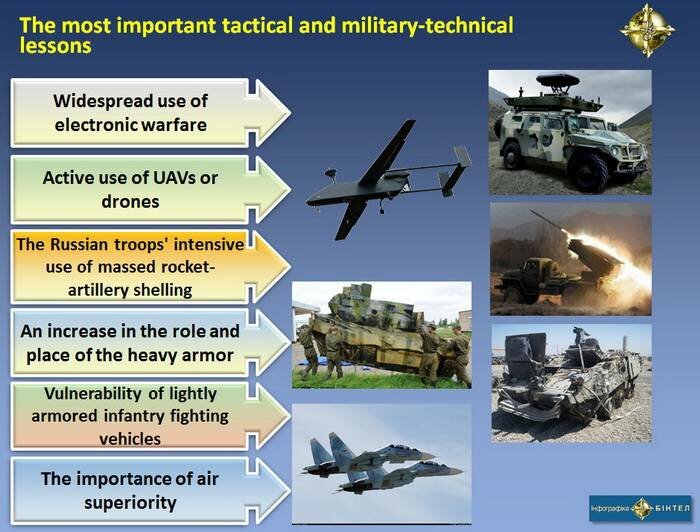 Russian occupying troops' widespread use of forces and means (including new models) of electronic warfare (EW)
Russian occupying troops' widespread use of forces and means (including new models) of electronic warfare (EW)
Russia uses the radio-electronic war in the Donbas to achieve four main objectives: first of all — destruction of the control facilities and communications centres by massive rocket and artillery fire on the activity of any sources of electromagnetic emission, the characteristics of which may be identified with the help of unmanned aerial vehicles or means of electronic intelligence (ELINT); blocking any electromagnetic means of communication; suppression of unmanned aerial vehicles by interfering with the control or the passage of the GPS-signal; creating obstacles to the use of enemy artillery and mortars by bringing out of operation (through early detonation) of artillery or mortar shells, which have electronic fuses;
-
Active use of unmanned aerial vehicles (UAVs or drones) on both sides of the front
At this, Russia effectively uses UAVs for intelligence, surveillance and reconnaissance; determining the coordinates of targets to deliver massive missile and artillery attacks in real-time mode, and more recently as mini-bombers, including with incendiary munitions, aimed at fuel and ammunition storage sites.
The combination of UAVs' small sizes, their limited radar profile or infrared characteristics, as well as the complicatedness of detecting UAVs (usually just above or after the passage of the target), makes using against them missile systems of "ground-to-air" class unlikely and expensive;
-
The Russian occupying troops' intensive use of massed rocket-artillery shelling
The improved efficiency of the air surveillance systems based on UAVs in conjunction with the massive artillery and MLRS firing has led to a new level of intensity of modern conventional fighting.
Russia skillfully uses a combination of actions of the advanced conventional ammunition, means of remote mining, cluster munitions (for the destruction from above) and thermobaric munitions that has disastrous consequences of their use during the planned massive fire strikes. The results of the conflict in the Donbas show that rocket — artillery fire is responsible for approximately 80 % of all the victims.
At the same time the combination of unmanned aerial vehicles and artillery systems, with the growing role of counter-battery radars and counter-battery fire on the battlefield reduces the enemy's ability to apply fire strikes, forcing it to constantly change position;
-
An increase in the role and place of the heavy armor on the battlefield
The role and place of main battle tanks (MBT) are decisive on the modern battlefield, if they are equipment with means to counter anti-tank missile systems (ATMS) and light anti-tank weapon (colloquially termed Rocket Propelled Grenades from the Russian abbreviation of Reaktivnyi Protivotankovyi Granatomyot — RPG).
For example, the modern Russian T-72B3 has upgraded armor, is equipped with dynamic protection system, a new version of the 125-mm gun, and most importantly, with an advanced computerized fire control system with improved optics and modern night/all-weather vision devices.
The main Battle Tank T-90 also has all these improvements, but its most important feature is the integrated system of active protection Using a radar to detect missiles approaching the tank, this system of protection shoots like a shotgun, a veil of “buckshot” (aerosol grenades), preventing the self-homing of the antitank guided missiles.
Having taken into consideration the experience of the war in the Donbas, Russia has also developed modular systems of active protection to be used also for MBT T-80, T-72 and T-64;
-
Vulnerability of lightly armored infantry fighting vehicles
Lightly armored infantry fighting vehicles (IFV), the mobility and firepower of which take precedence over their survivability, are vulnerable to anti-tank weapons, medium (30 mm) caliber automatic guns, cluster and thermobaric artillery munitions. When hit, the crews of armored infantry fighting vehicles usually have significant losses in killed or seriously wounded, so they also need to be equipped with integrated systems of active protection;
-
The importance of air superiority
Russian occupying forces have created at the Donbas a very dense network of mobile air defense. The combination of integrated and combined into a single network self-propelled air defense systems, man-portable air defense systems (MANPADS) have actually squeezed the Ukrainian aviation out of its own sky.
That is why Ukraine is facing an urgent task — to gain superiority in the air by adequate suppression and destruction of the enemy's air defense systems, as well as of their secure bases and positions.
Information (information-propaganda) conclusions and lessons
- The main conclusion and lesson of Russia's information-propaganda war against Ukraine as an important component of a “hybrid war”, is its unprecedented nature in its content, scope and direction:
Firstly, the information war started long before Russia's military aggression against Ukraine and continues to accompany it at all stages, getting adapted to the current goals and tasks in advance;
secondly, information–propaganda and misinformation projects, operations and measures are aimed at all strata of the population and all regions of Ukraine, as well as the population of Russia and the Western countries — respectively, with different goals and tasks;
thirdly, the main goal of Russia's information war in Ukraine is to eliminate Ukraine's statehood; in Russia — to ensure public support to justify the actions of Russia's leadership; in the countries of the West — to discredit the actions of the leadership of Ukraine and the Ukrainian Armed Forces. - Since the beginning of Ukraine's resistance to the military aggression of the Russian Federation in Donetsk and Luhansk regions, as well as of the occupation and annexation of the Ukrainian Crimea, the information policy of the Russian Federation has transformed into a total military misinformation aggression aimed at the demonization of the current Ukrainian leadership in the eyes of the Russian population and international community.
- To counteract the Russian misinformation is only possible in close cooperation with information resources of democratic countries of the West, directing and coordinating the joint work not only in terms of clarification of the current Russian information actions, but also proactively and actively counteracting them.
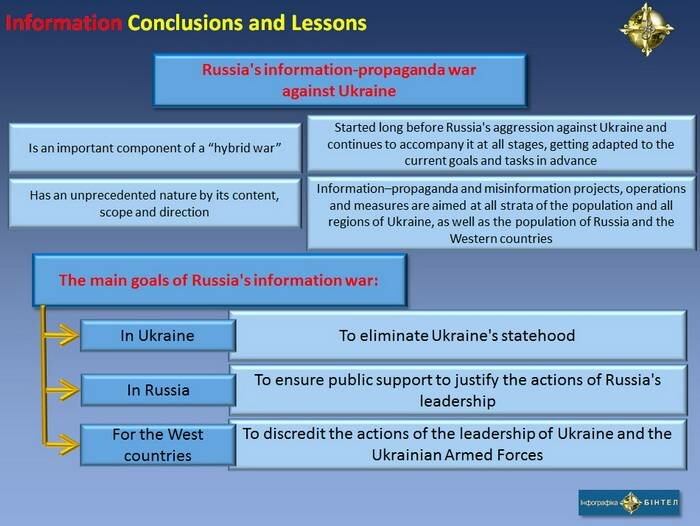
|

|
So, the two and a half years of Russia's military intervention in Ukraine have exposed vulnerabilities in the security and defense sectors of Ukraine, united Europe (EU) and the USA/NATO, and in the international security system as a whole.
Taking into consideration the lessons of Russia's “hybrid war” in Ukraine, which should be drawn from the Russian-Ukrainian conflict in the Donbas by the Armies of Ukraine and of the leading countries of the West, will definitely contribute to the development and strengthening of the security and defense sector of individual countries and coalitions of countries in terms of “new generation warfare".
Russia's continuation of the “hybrid war” against Ukraine in the scope and forms of this year, would lead to Ukraine's gradual exhaustion against the background of a possible termination/easing of international sanctions against Russia. In such circumstances, the settlement of the Russian-Ukrainian conflict will require seeking new and far more rational options.
Delaying in time the resolving of the conflict would certainly end in its getting “frozen”, which would almost automatically (and for Putin's Kremlin's joy) “put an end” to Ukraine's European and Euro-Atlantic prospects for an indefinite period, and could possibly lead to Ukraine's losing its statehood.
The article was published in the edition of the Romanian Center “INGEPO Consulting Company” —
“Geostrategic Pulse” №225 from November 20, 2016
Next article: Lessons of Russia's “Hybrid War” against Ukraine–2: Geopolitical Dimension


